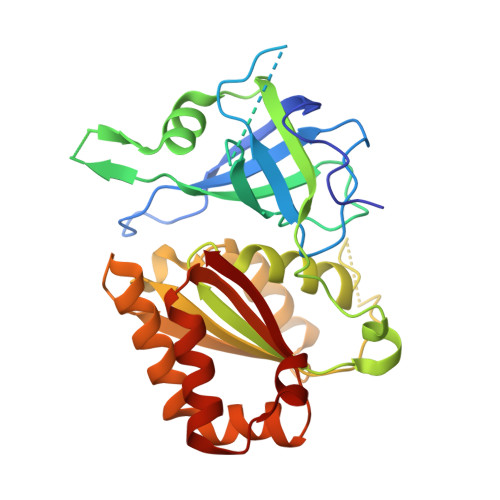Ferredoxin-NADP(+) Reductase from Plasmodium falciparum Undergoes NADP(+)-dependent Dimerization and Inactivation: Functional and Crystallographic Analysis.
Milani, M., Balconi, E., Aliverti, A., Mastrangelo, E., Seeber, F., Bolognesi, M., Zanetti, G.(2007) J Mol Biol 367: 501-513
- PubMed: 17258767
- DOI: https://doi.org/10.1016/j.jmb.2007.01.005
- Primary Citation of Related Structures:
2OK7, 2OK8 - PubMed Abstract:
The completion of the Plasmodium falciparum genome sequence has recently promoted the search for new antimalarial drugs. More specifically, metabolic pathways of the apicoplast, a key organelle for survival of the parasite, have been recognized as potential targets for the development of specific new antimalarial agents. As most apicomplexan parasites, P. falciparum displays a plant-type ferredoxin-NADP(+) reductase, yielding reduced ferredoxin for essential biosynthetic pathways in the apicoplast. Here we report a molecular, kinetic and ligand binding characterization of the recombinant ferredoxin-NADP(+) reductase from P. falciparum, in the light of current data available for plant ferredoxin-NADP(+) reductases. In parallel with the functional characterization, we describe the crystal structures of P. falciparum ferredoxin-NADP(+) reductase in free form and in complex with 2'-phospho-AMP (at 2.4 and 2.7 A resolution, respectively). The enzyme displays structural properties likely to be unique to plasmodial reductases. In particular, the two crystal structures highlight a covalent dimer, which relies on the oxidation of residue Cys99 in two opposing subunits, and a helix-coil transition that occurs in the NADP-binding domain, triggered by 2'-phospho-AMP binding. Studies in solution show that NADP(+), as well as 2'-phospho-AMP, promotes the formation of the disulfide-stabilized dimer. The isolated dimer is essentially inactive, but full activity is recovered upon disulfide reduction. The occurrence of residues unique to the plasmodial enzyme, and the discovery of specific conformational properties, highlight the NADP-binding domain of P. falciparum ferredoxin-NADP(+) reductase as particularly suited for the rational development of antimalarial compounds.
Organizational Affiliation:
CNR-INFM, Department of Biomolecular Sciences and Biotechnology, University of Milano, Via Celoria 26, 20133-Milano, Italy.
















